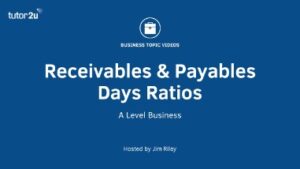
They provide a way of expressing the relationship between one accounting data point to another and are the basis of ratio analysis. They also serve as a comparison toolbox to compare the firms’ performance to that of its peer these tax credits could boost refunds for low in the same industry. If financial accounting is all about balance sheets and income statements, cost accounting is all about ratios and formulas.
Quick assets are current assets that can be converted into cash within 90 days. Accounting ratios are a crucial tool for analyzing financial statements – they compare accounting and bookkeeping services the connection between two figures in your financials. The only difference in the calculation is the inclusion of any inventory totals.
What are accounting ratios?
I’ve created a quick reference guide on my LinkedIn profile for all the above accounting ratios. Save the post for the future, and follow me for more expert advice for current and future managerial accountants. The inventory turnover ratio is the number of times a company has sold and replenished its inventory over a specific period. To say it another way – the ratio indicates a company’s reliance on debt rather than equity to finance assets. To analyze the proportion of debt a company carries, you divide the total debt by total assets. The ratio indicates the percentage of each dollar of revenue a company retains as gross profit and is calculated by subtracting COGS from revenue and dividing by revenue.
Great! The Financial Professional Will Get Back To You Soon.
- A higher asset turnover ratio is better, showing the company produces more sales per asset owned and indicates an efficient use of those assets.
- A savvy investor knows how to use accounting ratios to determine whether a stock presents a lucrative opportunity or perhaps a liability that other investors have yet to realize.
- To phrase it differently, gross margin tells the story of a company’s profit after paying off its cost of goods sold (COGS).
We collaborate with business-to-business vendors, connecting them with potential buyers. In some cases, we earn commissions when sales are made through our referrals. These financial relationships support our content but do not dictate our recommendations. Our editorial team independently evaluates products based on thousands of hours of research. A financial professional will offer guidance based on the information provided and offer a no-obligation call to better understand your situation. For information pertaining to the registration status of 11 Financial, please contact the state securities regulators for those states in which 11 Financial maintains a registration filing.
If your company has current assets of $90,000 and inventory of $30,000, your current asset total would be $60,000. You would then divide that number by the amount of your current liabilities, which are $35,000, to obtain your quick ratio. Using numbers from your income statement, take your total revenue and subtract cost of goods sold. That total is then divided by revenue to obtain your gross profit margin. The current ratio compares the current assets to the current liabilities of the business. This ratio indicates whether the company can settle its short-term liabilities.
What is your current financial priority?
But sticking with it can give you a clear picture of your company’s current financial health so you can make crucial decisions. Profitability ratios measure how successful the company has been in generating profits on its investments in assets or operations as compared to sales revenue. Examples include Gross Profit Margin, Operating Profit Margin united nations civil society participation and Net Profit Margin.

11 Financial is a registered investment adviser located in Lufkin, Texas. 11 Financial may only transact business in those states in which it is registered, or qualifies for an exemption or exclusion from registration requirements. This ratio can also calculate how long it will take to move the on-hand inventory. A higher ratio outcome is generally a more positive indicator of profitability. This allows you to see exactly how much profit you make after all expenses are paid, giving you a good indication of how well your business is performing overall.
The debt service coverage ratio is a measure of a company’s ability to meet its fixed debt payments. The formula for calculating the debt service coverage ratio is net income before interest and tax divided by fixed interest charges. The asset turnover ratio measures how efficiently a company uses its assets to generate sales. Debt ratios, sometimes known as leverage ratios, are financial calculations that measure the extent of a company’s leverage – or the proportion of debt-financed assets.